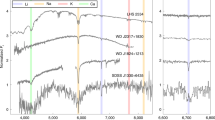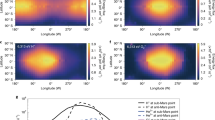Abstract
The composition and evolutionary history of Mercury's crust are not well determined1,2. The planet as a whole has been predicted3 to have a refractory, anhydrous composition: rich in Ca, Al, Mg and Fe, but poor in Na, K, OH, and S. Its atmosphere is believed to be derived in large part from the surface materials. A combination of effects that include impact vaporization (from infalling material), volatile evaporation, photon-stimulated desorption and sputtering releases material from the surface to form the atmosphere. Sodium and potassium have already been observed in Mercury's atmosphere4,5,6, with abundances that require a volatile-rich crust7. The sodium probably results from photon-stimulated desorption8,9, and has a temperature of 1,500 K (ref. 10). Here we report the discovery of calcium in the atmosphere near Mercury's poles. The column density is very low and the temperature is apparently very high (12,000 K). The localized distribution and high temperature, if confirmed, suggest that the atmospheric calcium may arise from surface sputtering by ions, which enter Mercury's auroral zone. The low abundance of atmospheric Ca may indicate that the regolith is rarefied in calcium.
This is a preview of subscription content, access via your institution
Access options
Subscribe to this journal
Receive 51 print issues and online access
$199.00 per year
only $3.90 per issue
Buy this article
- Purchase on Springer Link
- Instant access to full article PDF
Prices may be subject to local taxes which are calculated during checkout


Similar content being viewed by others
References
Goettel, K. A. in Mercury 613–621 (Univ. Arizona Press, Tucson, 1988).
Lewis, J. S. in Mercury 651–666 (Univ. Arizona Press, Tucson, 1988).
Lewis, J. S. Metal/silicate fractionation in the solar system. Earth Planet Sci. 15, 286–290 ( 1992).
Potter, A. E. & Morgan, T. H. Discovery of sodium in the atmosphere of Mercury. Science 229, 651– 653 (1985).
Potter, A. E. & Morgan, T. H. Potassium in the atmosphere of Mercury. Icarus 67, 336– 340 (1986).
Sprague, A. L. et al. Distribution and abundance of sodium in Mercury's atmosphere, 1985–1988. Icarus 129, 506– 527 (1997).
Killen, R. M. & Morgan, T. H. Maintaining the Na atmosphere of Mercury. Icarus 101, 293– 312 (1993).
McGrath, M. A., Johnson, R. E. & Lanzerotti, L. J. Sputtering of sodium on the planet Mercury. Nature 323, 694–696 ( 1986).
Yakshinskiy, B. V. & Madey, T. E. Photon-stimulated desorption as a substantial source of sodium in the lunar atmosphere. Nature 400, 642–644 ( 1999).
Killen, R. M., Potter, A. E., Fitzsimmons, A. & Morgan, T. H. Sodium D2 line profiles: clues to the temperature structure of Mercury's exosphere. Planet. Space Sci. 47, 1449– 1458 (1999).
Vogt, S. S. et al. HIRES: the high-resolution echelle spectrometer on the Keck 10-m telescope. Proc. S.P.I.E. 2198, 362 (1994).
Chamberlain, J. W. & Hunten, D. M. Theory of Planetary Atmospheres (Academic Press, Orlando, 1987).
Kurucz, R. L., Furenlid, I., Brault, J. & Testerman, L. Solar Flux Atlas From 296 to 1300 nm, National Solar Observatory Atlas No. 1 (Harvard Univ. Press, Boston, 1984).
Cheng, A. F., Johnson, R. E., Krimigis, S. M. & Lanzerotti, L. J. Magnetosphere, exosphere and surface of Mercury. Icarus 71, 430–440 (1987).
Madey, T. E., Yakshinsky, V. N., Ageev, V. N. & Johnson, R. E. Desorption of alkali atoms and ions from oxide surfaces: relevance to origins of Na and K atmospheres of Mercury and the Moon. J. Geophys. Res. 103, 5873–5887 ( 1998).
Chamberlain, J. W. Spectral line profiles for a planetary corona. J. Geophys. Res. 81, 1774–1776 ( 1976).
Elphic, R. C. et al. Lunar surface composition and solar wind-induced secondary ion mass spectrometry. Geophys. Res. Lett. 18, 2165–2168 (1991).
Sugita, S., Schultz, P. H. & Adams, M. A. In situ temperature measurements of impact-induced vapor clouds with spectroscopic methods. Proc. Lunar Planet. Sci. Conf. 28, 1393–1394 ( 1997).
Morgan, T. H. & Killen, R. M. A non-stoichiometric model of the composition of the atmospheres of Mercury and the Moon. Planet. Space Sci. 45, 81–94 ( 1997).
Sprague, A. L., Koslowski, R. W. H., Hunten, D. M. & Grosse, F. A. An upper limit on neutral calcium in Mercury's atmosphere. Icarus 104, 33–37 ( 1993).
Sprague, A. L., Nash, D. B., Witteborn, F. C. & Cruikshank, D. P. Mercury's feldspar connection: mid-IR measurements suggest plagioclase. Adv. Space Res. 19, 1507–1510 (1997).
Jeanloz, R., Mitchell, D. L., Sprague, A. L. & dePater, I. Evidence for a basalt free surface on Mercury and implications for internal heat. Science 268, 1455– 1457 (1995).
Sprague, A. L., Schmitt, W. J. & Hill, R. E. Mercury: Sodium atmospheric enhancements, radar bright spots and surface features. Icarus 136, 60–68 (1998).
Acknowledgements
The data presented here were obtained at the W.M. Keck Observatory, which is operated as a scientific partnership between the California Institute of Technology, the University of California and the National Aeronautics and Space Administration. The observatory was made possible by the generous financial support of the W.M. Keck Foundation. We are grateful to the WMKO Observing Assistants for their help while conducting the observations. R.M.K. acknowledges the support of a NASA grant.
Author information
Authors and Affiliations
Corresponding author
Rights and permissions
About this article
Cite this article
Bida, T., Killen, R. & Morgan, T. Discovery of calcium in Mercury's atmosphere. Nature 404, 159–161 (2000). https://doi.org/10.1038/35004521
Received:
Accepted:
Issue Date:
DOI: https://doi.org/10.1038/35004521
This article is cited by
-
Future Directions for the Investigation of Surface-Bounded Exospheres in the Inner Solar System
Space Science Reviews (2023)
-
Review of Mercury’s dynamic magnetosphere: Post-MESSENGER era and comparative magnetospheres
Science China Earth Sciences (2022)
-
Volatiles and Refractories in Surface-Bounded Exospheres in the Inner Solar System
Space Science Reviews (2021)
-
BepiColombo Science Investigations During Cruise and Flybys at the Earth, Venus and Mercury
Space Science Reviews (2021)
-
PHEBUS on Bepi-Colombo: Post-launch Update and Instrument Performance
Space Science Reviews (2020)
Comments
By submitting a comment you agree to abide by our Terms and Community Guidelines. If you find something abusive or that does not comply with our terms or guidelines please flag it as inappropriate.



